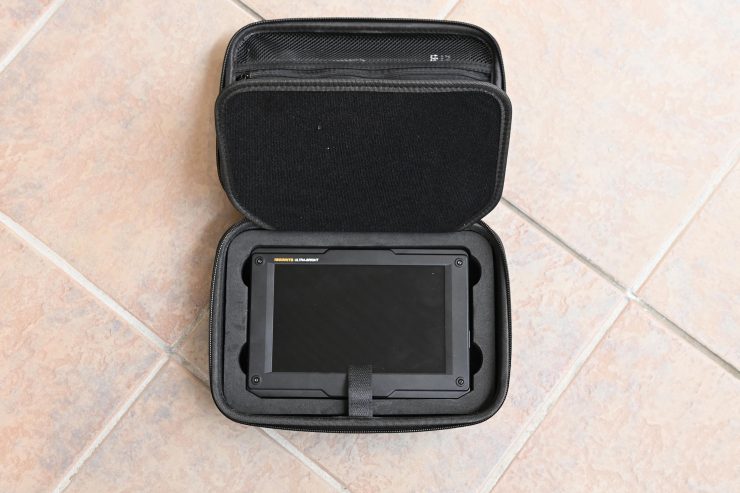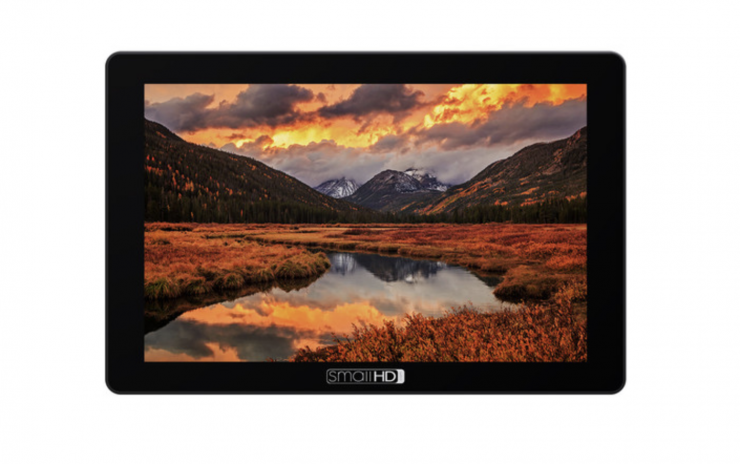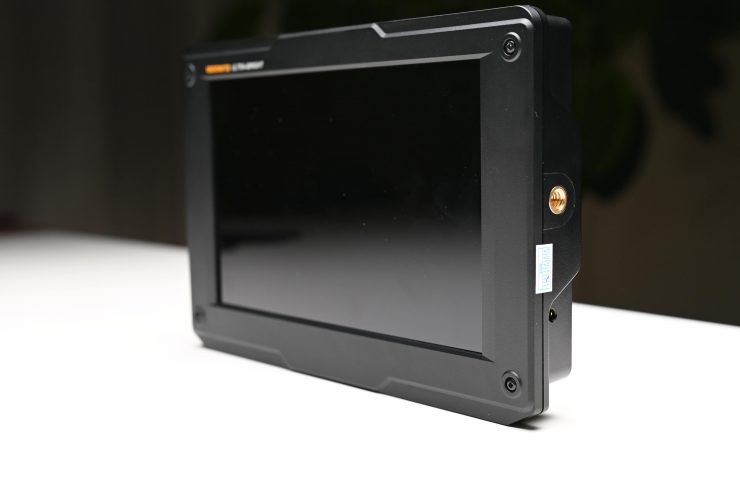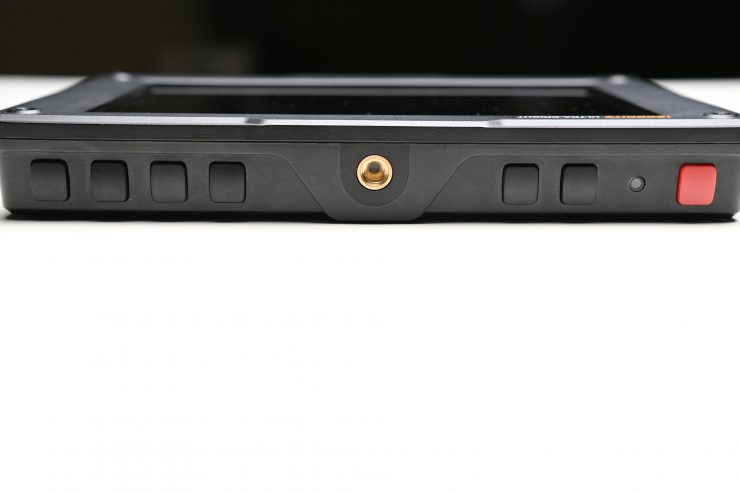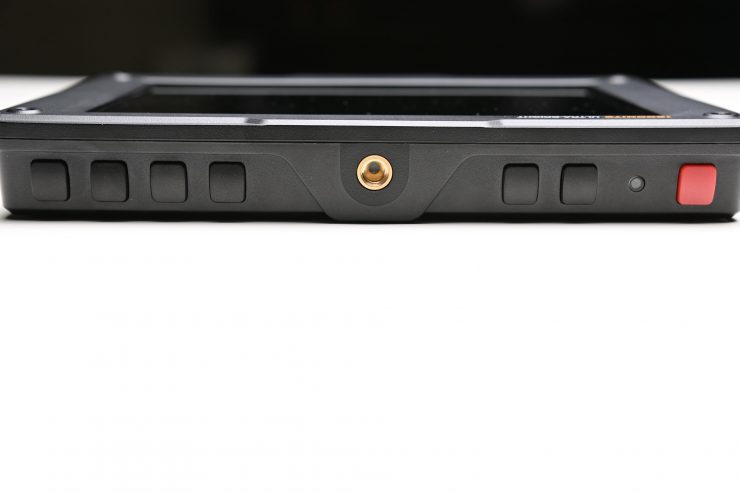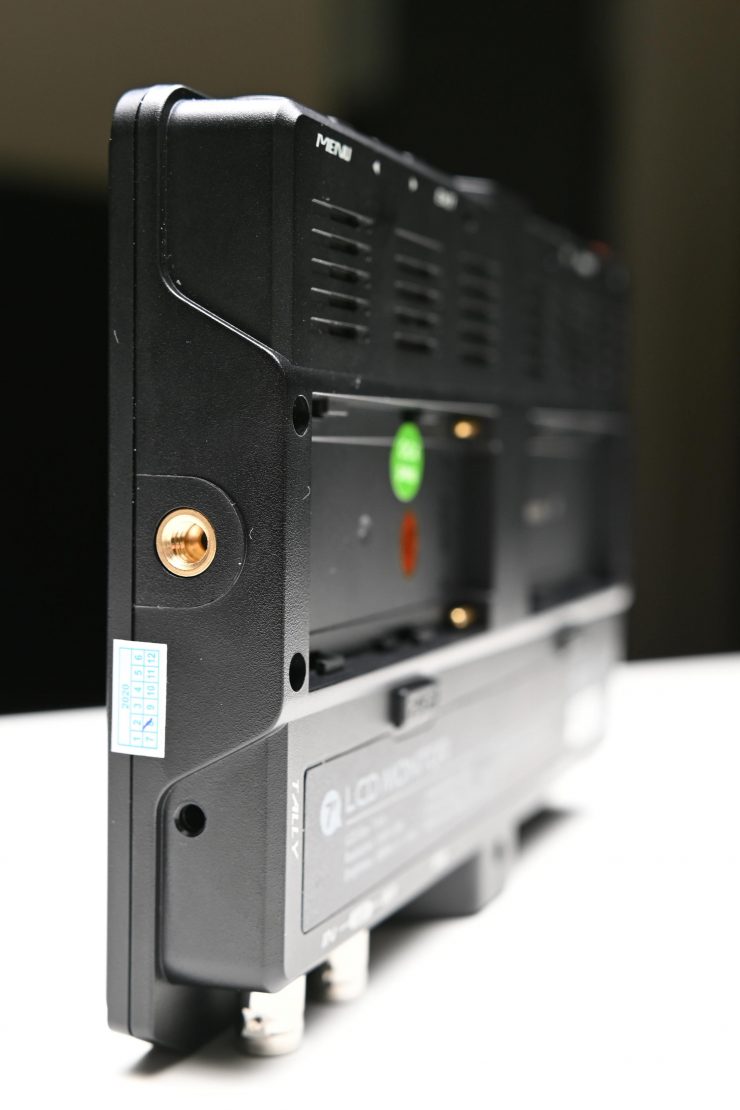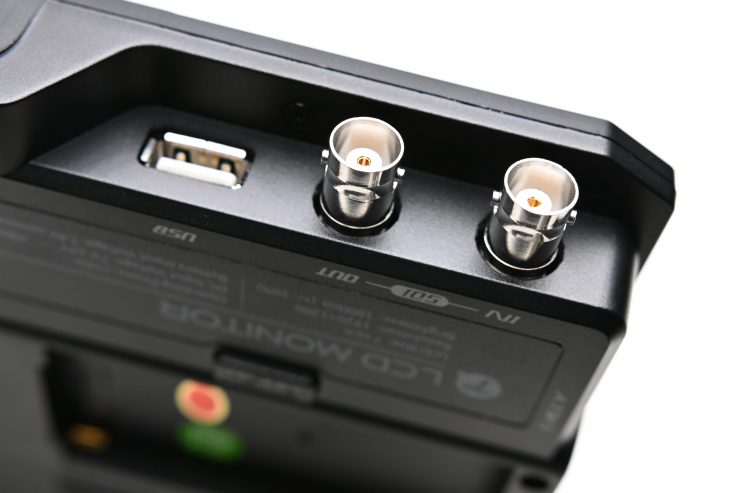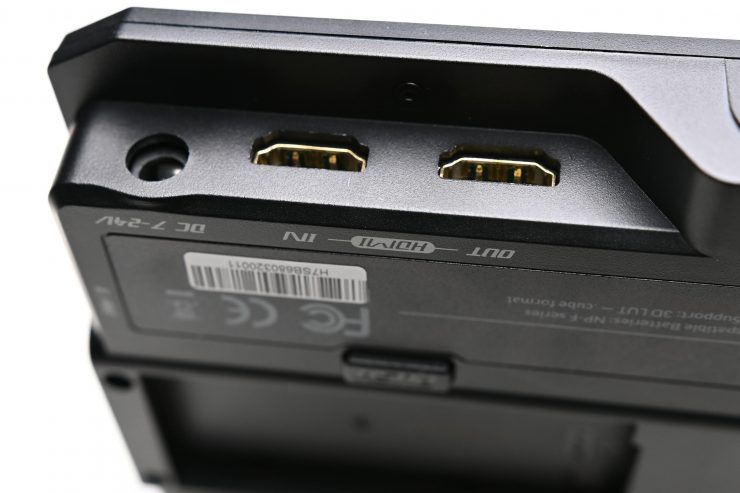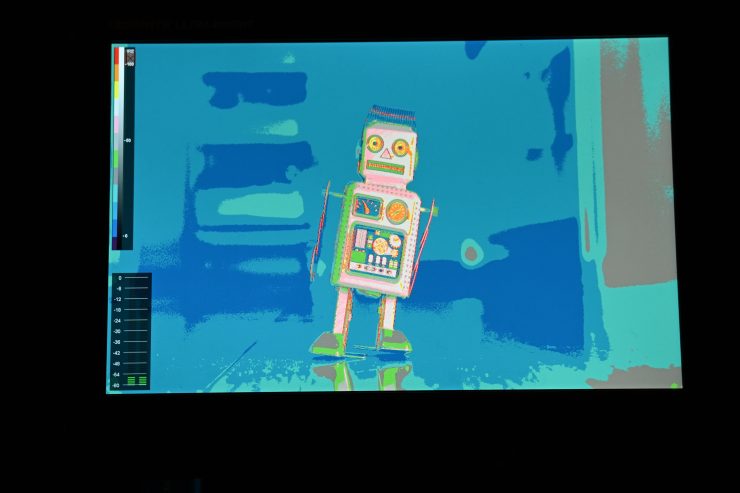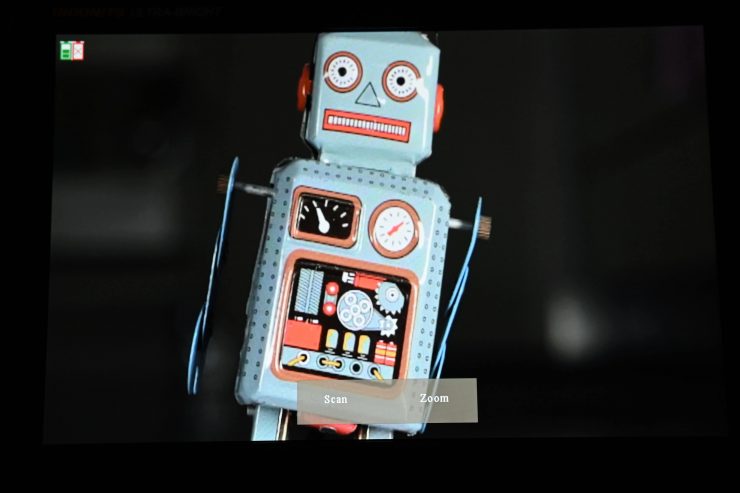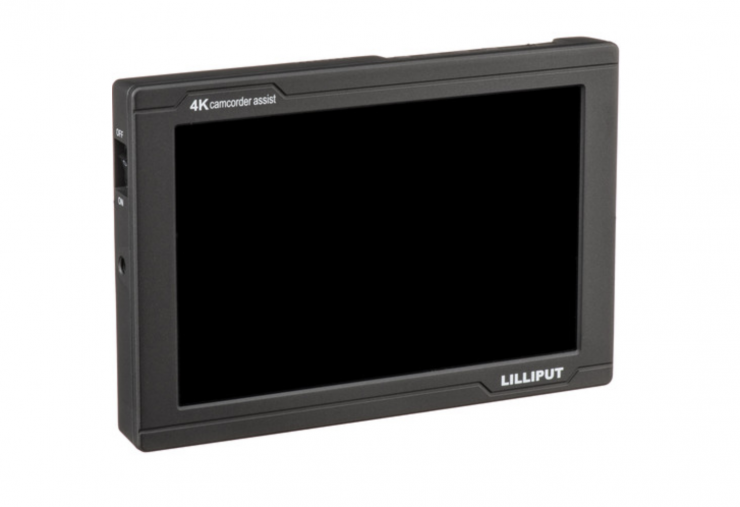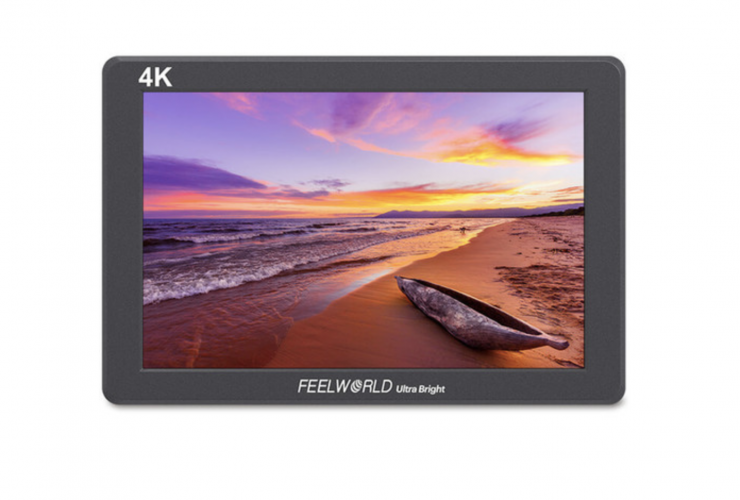
pnbe has announced a range of new high-bright monitors in sizes ranging from 5″ to 7″. These new HDR 4K field monitors range in brightness from 2000-3000 nits.
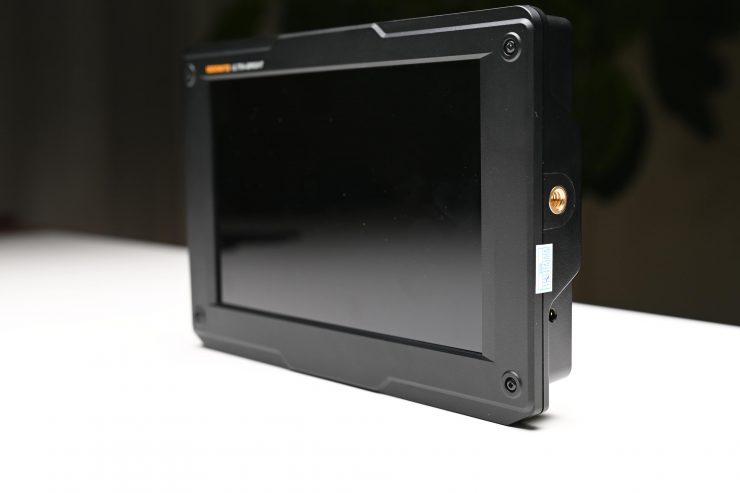
I will be looking specifically at the 7″ 2000 NIT HDR Monitor. Please bear in mind that this is a very early model and it may not entirely represent the actual shipping versions.
Who is pnbe?
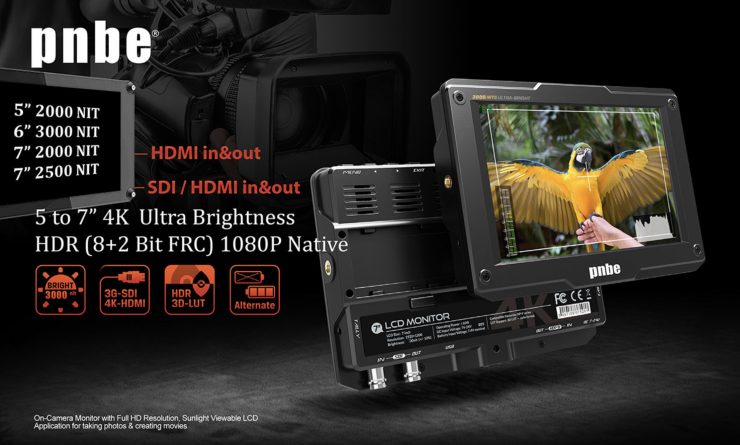
Now, you may be asking yourself ‘Who is pnbe?’ That is a good question. pnbe is an association of broadcasters and cinematographers that are based out of Spain and Italy. They are a non-profit organization that was founded with the idea of bringing products to the filming community at cost price. Their mantra is to provide us no more benefit than to sustain this association and to continue producing products at the manufacturing price.
Essentially pnbe wants to bring products to market for filmmakers without making any profit.
What do you get?
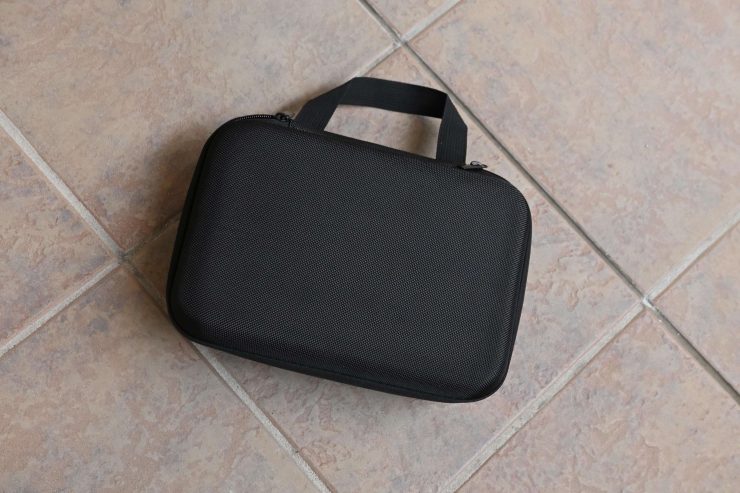
pnbe gives you the monitor, a carry case, instruction manual, a cold shoe monitor mount, a full size to mini HDMI cable, and a 3.5mm jack with unterminated cables on the end.
Screen
The screen is a 7″ 1920×1080 (8+2 FRC) IPS LCD panel. According to pnbe, the screen being used is exactly the same as the one that can be found on the SmallHD CINE 7. I have no way of confirming this. The screen has a contrast ratio of 1200:1 and a viewing angle of 160 degrees. pnbe claims it has 2000 nits of brightness.
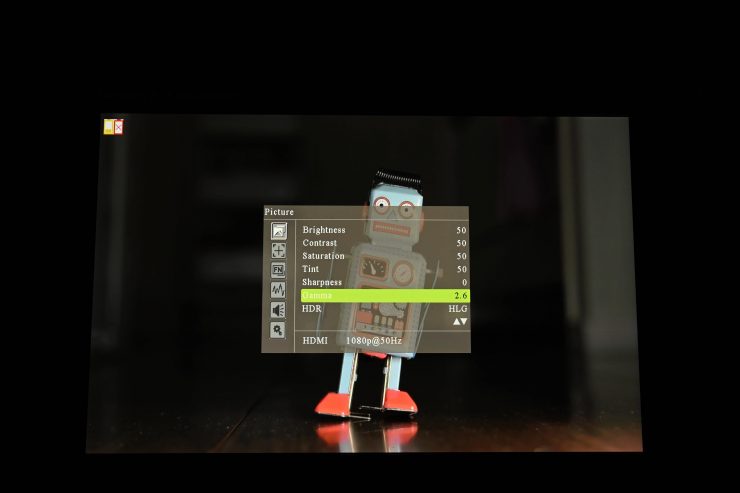

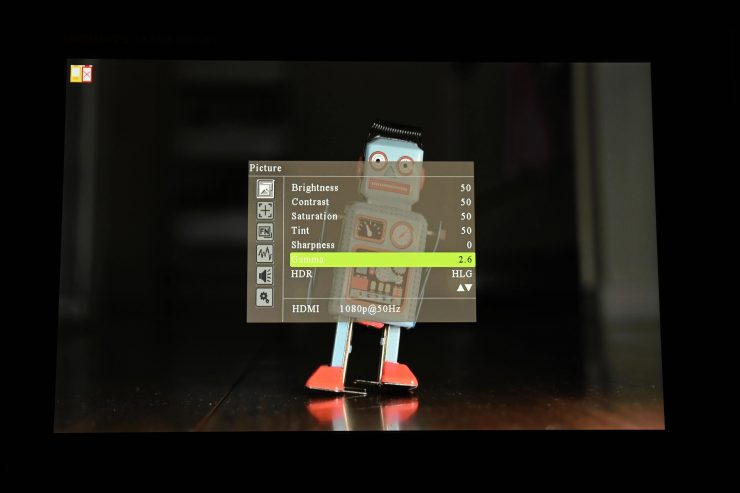
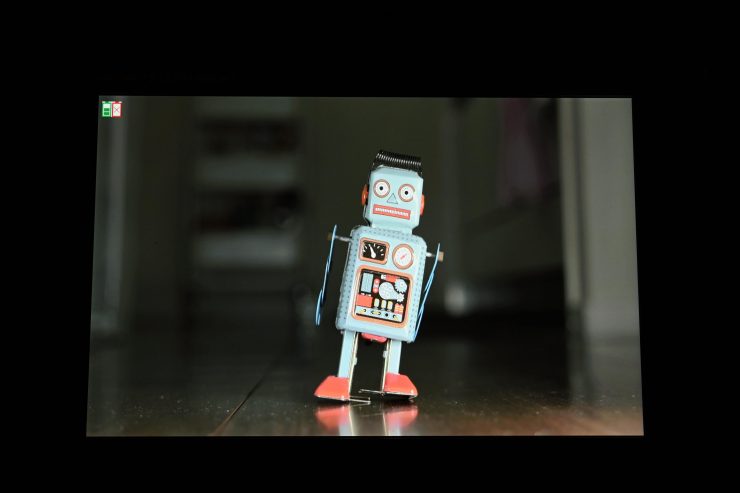
Gamma 1.8 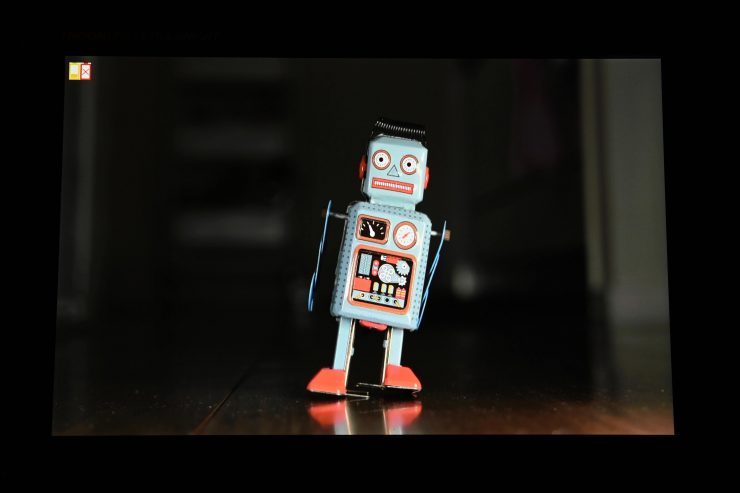
Gamma 2.6
You can change the Kelvin color temperature of the display, as well as the Gamma. Gamma settings can be changed between the following:
- Off
- 1.8
- 2.0
- 2.2
- 2.35
- 2.4
- 2.6
Basically, the lowest gamma setting (1.8) will make your image brighter, while the highest gamma setting (2.6) will cause the image to appear darker.
HDR
You can turn HDR viewing on and off on the monitor. It supports the following:
- ST2084 300
- ST2084 1000
- ST2084 10,000
- HLG
Design
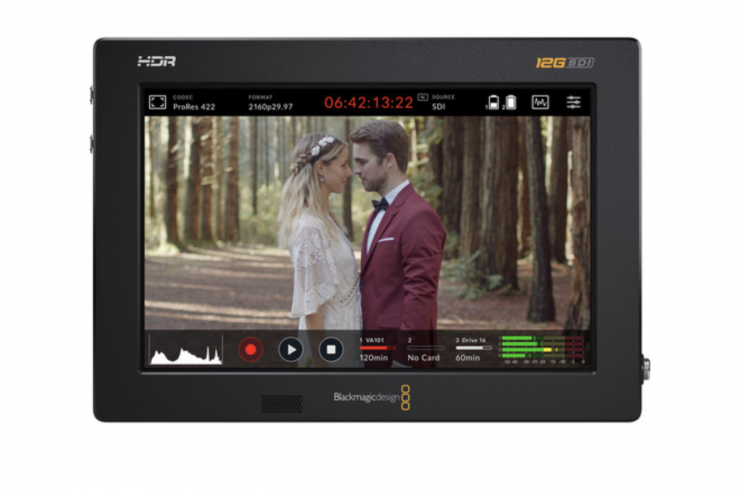
There are only so many ways you can design a monitor. To me, I think that the pnbe 7″ monitor looks like a cross between a SmallHD Cine7 and a Blackmagic Design Video Assist 7″.
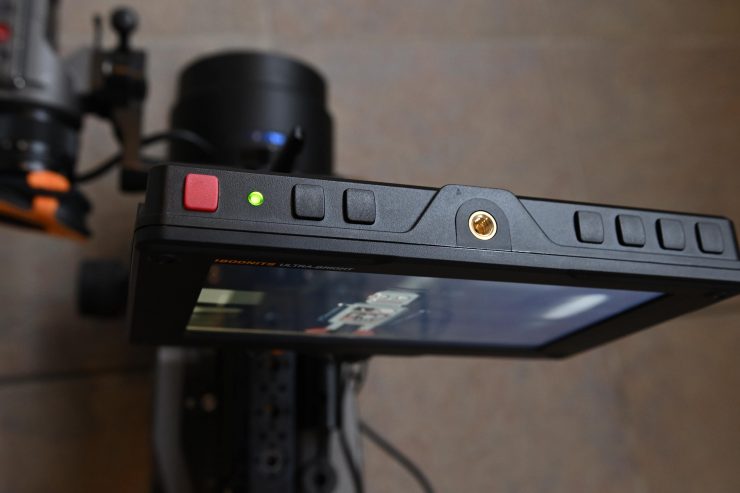
There is nothing overly unique or special about the design of the monitor. However, the positioning of all of the inputs and outputs is nice and I like the battery placement.
Build Quality
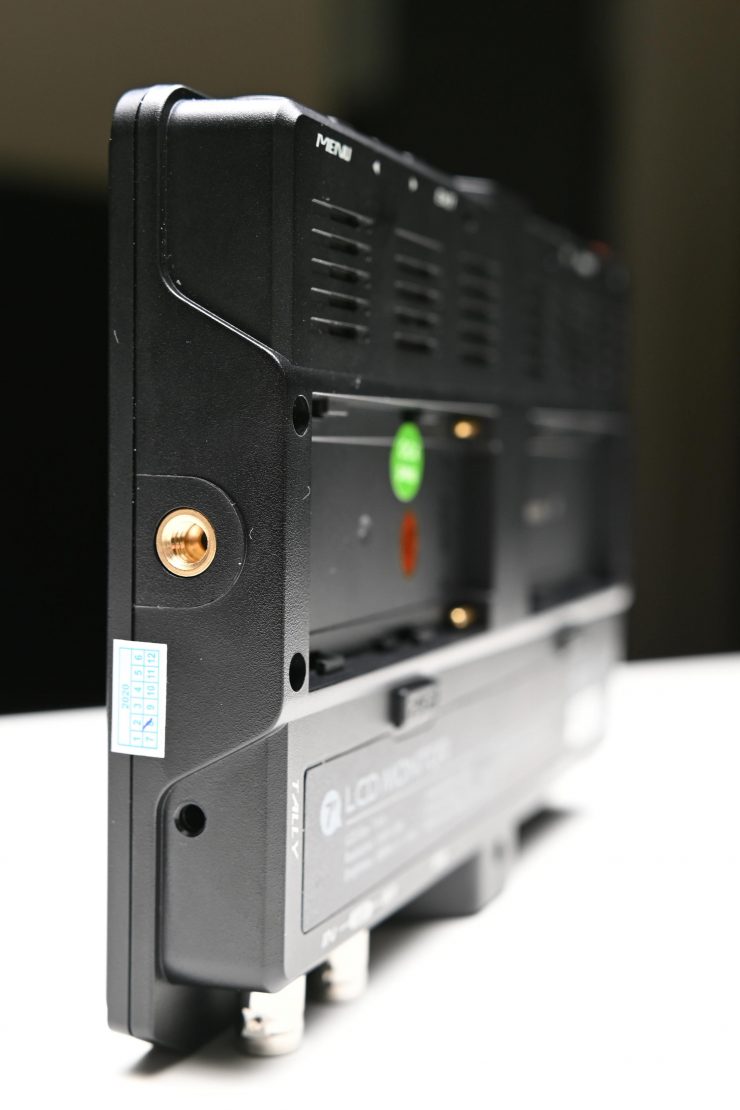
The build quality is ok, but it doesn’t feel as well made as say a SmallHD Cine 7. The casing of the monitor is reasonably robust, but the buttons do feel quite plasticky, and they could be a little better. They are also quite noisy when you press them and this could potentially be a problem when working in quiet environments.
Weight
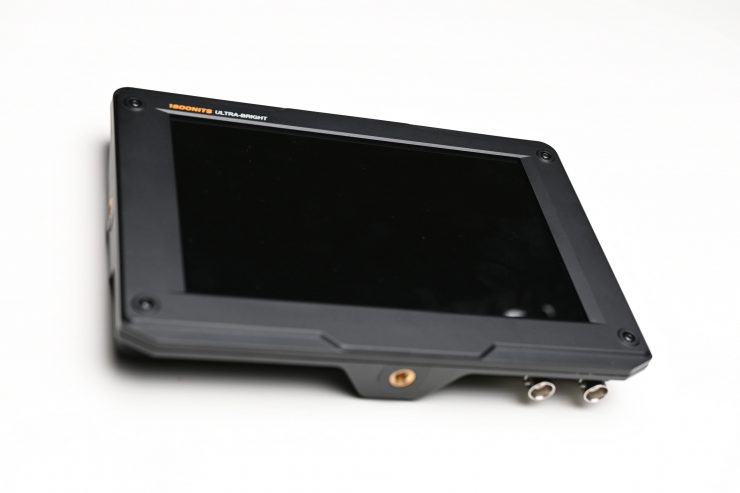
The pnbe 7″ monitor weighs in at 360 g (12.7 oz). As a comparison, the SmallHD Cine 7 tips the scales at 567 g (20 oz).
The pnbe monitor does feel quite light for a 7″ monitor and if you are using it with a small or mid-sized digital cinema camera then that may be an advantage.
Mounting Points
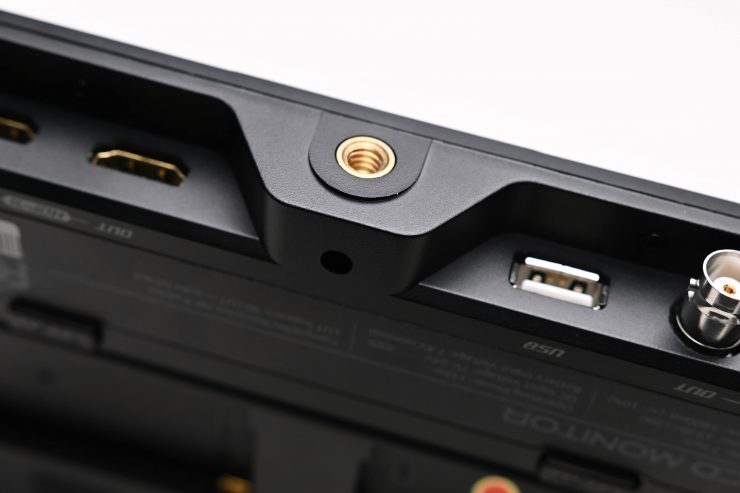
pnbe has put 1/4 20″ mounting points on all four sides of the monitor. This is nice to see and it allows you to mount it in a variety of ways.
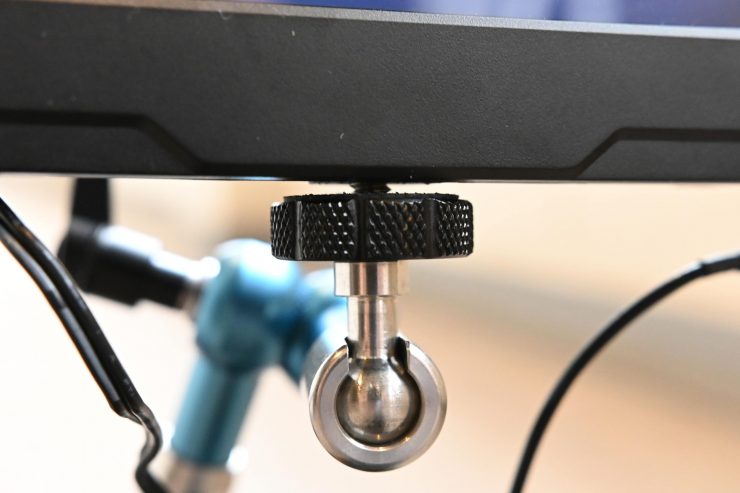
The problem I found with the 1/4 20″ mounting holes is that they don’t seem to be deep enough. I tried a range of monitor mounts and monitor arms and none of them went in far enough.
I made pnbe aware of this issue and they are looking into it.
Boot Up Time
The monitor takes around 5 seconds to boot up once you press the on button.
Inputs/Outputs
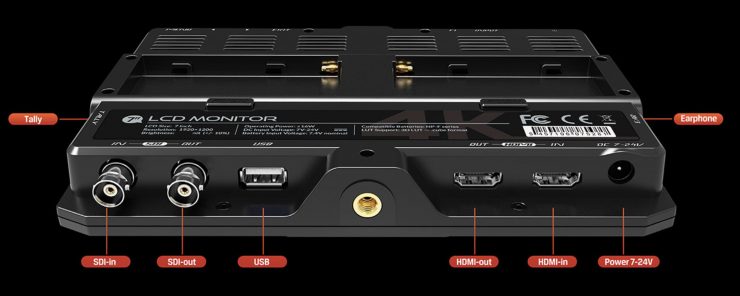
The monitor has a 3G SDI In and a 3G SDI Out, as well as an HDMI In and an HDMI out. You can loop signals through if need be.
The inputs and outputs are in a similar position to where they are located on the SmallHD Cine 7. It is always a good idea, at least in my opinion, to get a monitor that features both SDI and HDMI inputs/outputs. You may well only be using a camera at the moment that has an HDMI out, but what if you change cameras to something that uses SDI? Having both dramatically increases the versatility of any monitor.
Viewing Assist Tools
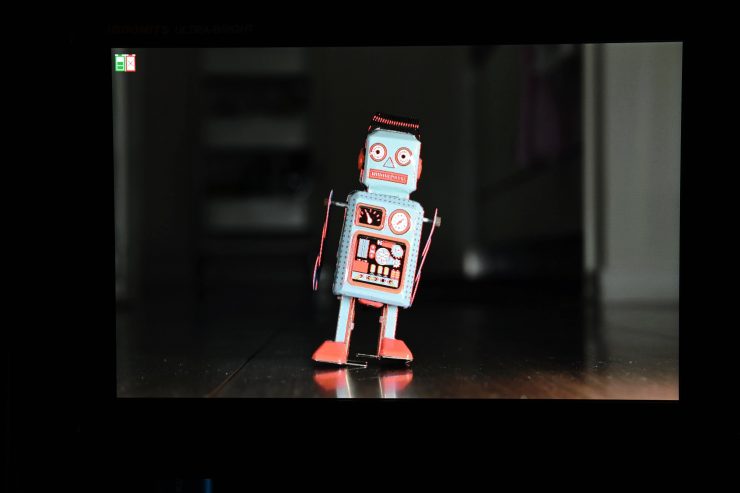
The monitor has quite an extensive array of monitoring assist tools:
- Histogram
- False Color
- Focus Peaking
- Zebras
- Check Field
- Aspect Ratio
- Image Zoom
- Audio Level Meters
- Image Flip
- H/V Delay
- Frame Markers
- Freeze Frame
The majority of these tools can be adjusted and customized. There is no waveform tool which is unfortunate.
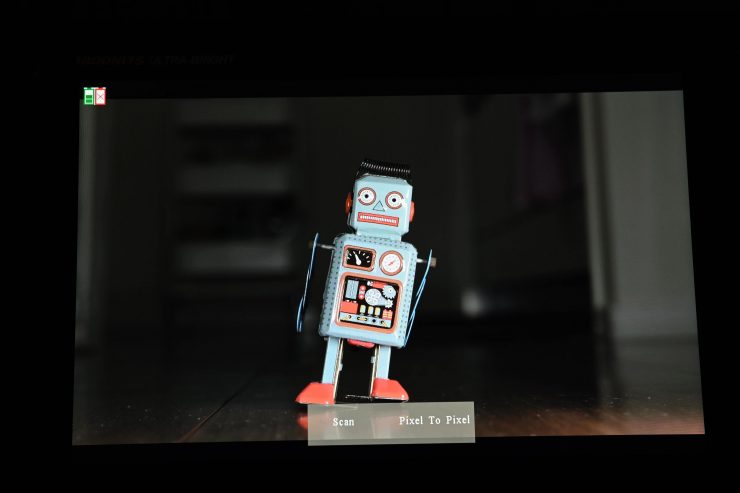
With Image Zoom, if you assign it to the function button you can choose between Pixel to Pixel and Zoom.


1.5x 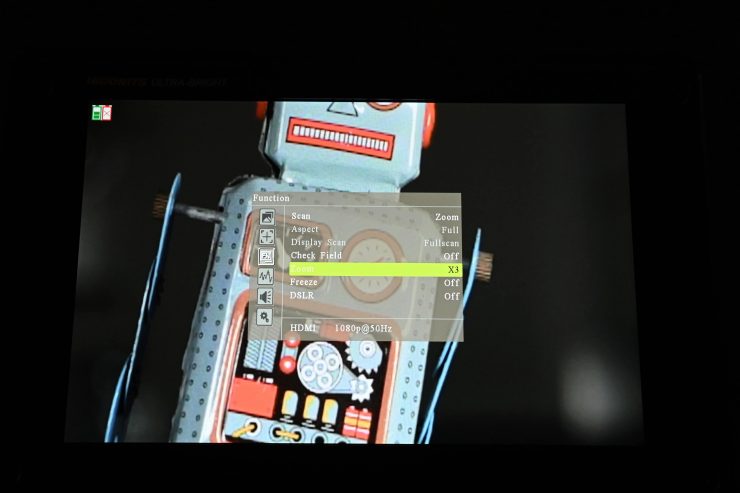
3x 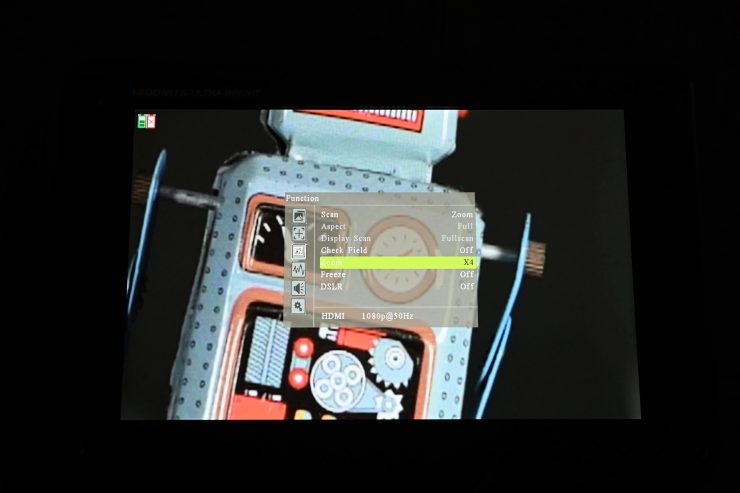
4x
The level of magnification depends on what you have pre-selected in the menu. You can choose from 1.5x, 2x, 3x, and 4x. Now, the only problem is that you can’t adjust where the zoom is on the screen. I also wish they had have made the Image Zoom in such a way that when you have it assigned to the function button it just cycles through the levels of magnification. Unfortunately, as it stands, if you have 2x selected in the menu and you want to change it to 4x you have to go back into the menu.
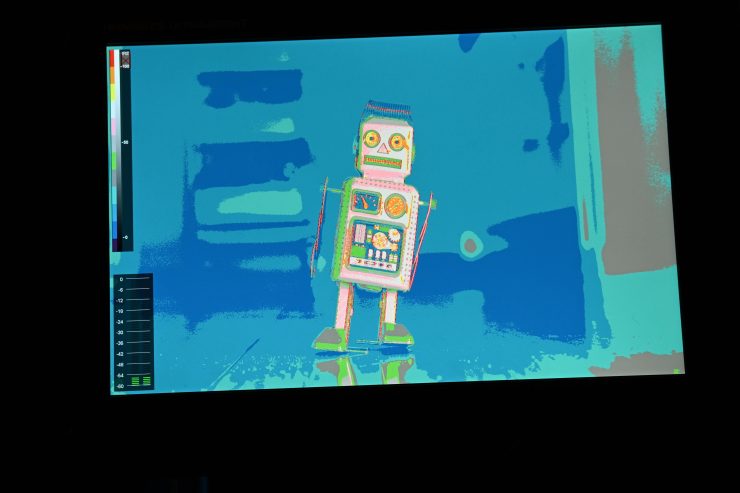

False Color 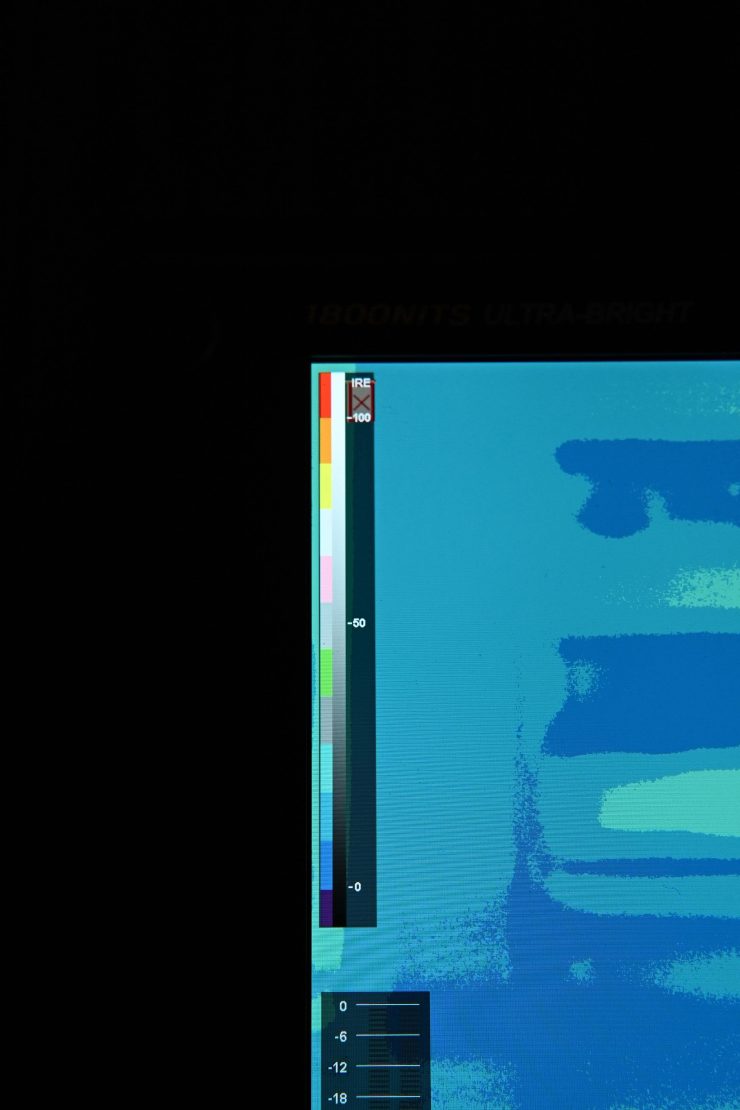
False Color guide 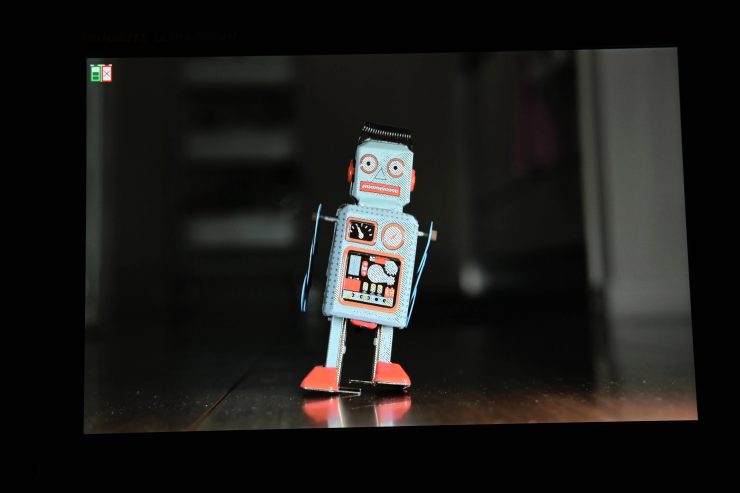
Zebras
I like the usability of both False Color and Zebras. With False Color, you get a clearly labeled false-color indicator guide and with zebras, you can adjust them from 0-100%. This is nice because you can set the exact level for middle grey on your camera and use that to get accurate expose.
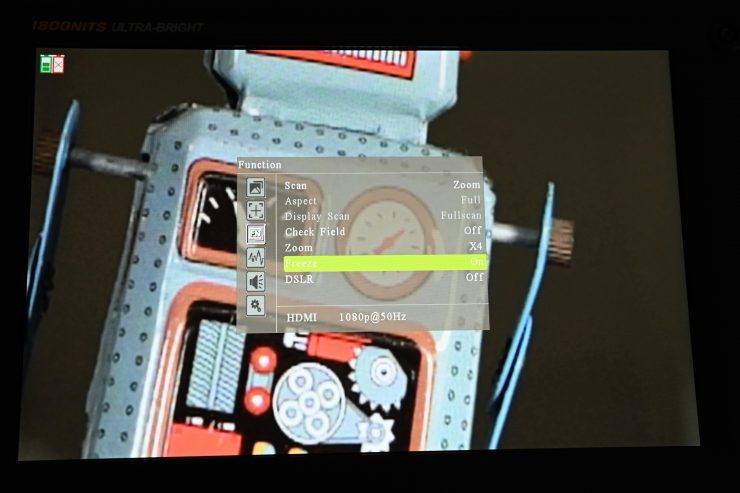
There is also a function called Freeze. Basically, if you set up a shot and then you go into the menu and turn Freeze on it will keep displaying that exact shot until you tun it off.
3D LUTs
You can load up 3D LUT via a USB flash drive. The monitor also has 8 pre-set onboard LUTs and you can store 6 of your own.
On the monitor I was testing these were the preset LUTs:
- S-Log2-LC709
- S-Log2-LC709 Type A
- S-Log2-S-Log2 709
- S-Log2-Cine+709
- S-Log3-LC709
- S-Log3-LC709 Type A
- S-Log3-S-Log2 709
- S-Log3-Cine+709
Power
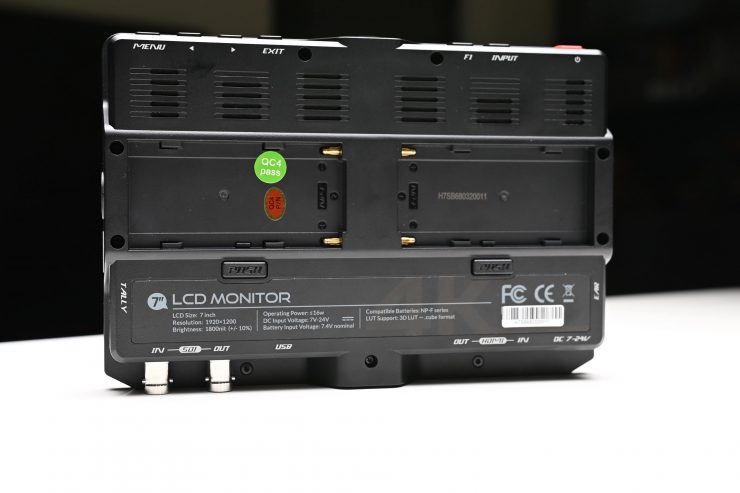
The monitor draws 16W and it can take an input voltage of 7-24V. It utilizes dual Sony NP battery plates. Batteries can be hot-swapped on the monitor.
The batteries don’t move around or wobble on the battery plates and they are easy to put on and remove.
Is it quiet?
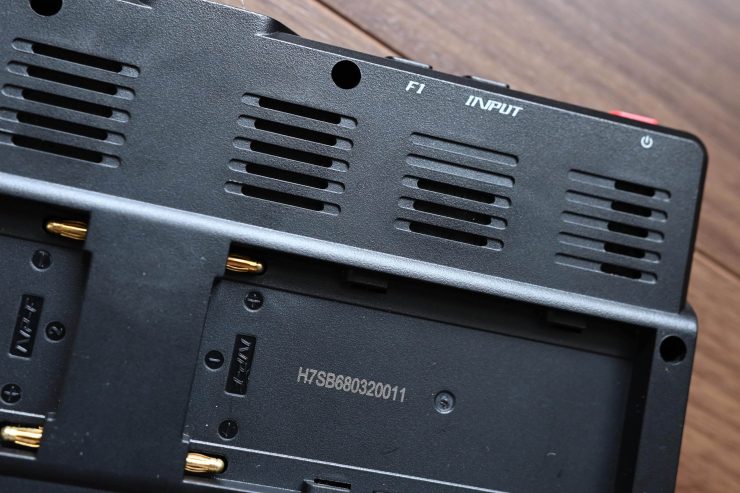
There is nothing worse than a monitor that has a very noisy fan. Some of the Atomos offerings sound like there is a mini hairdryer being used in the same room. The good news is that the pnbe is relatively quiet. While it does have a couple of fans, they are barely audible.
How is the image?
Image quality and usability are at least to me, the two biggest boxes that need to be ticked with any monitor that is going to be used in a professional environment.
As far as the image quality is concerned it is pretty good, however, for some strange reason, it seems to show a lot of banding and image artifacts. More on that later on.
Is it actually 2000 nits?
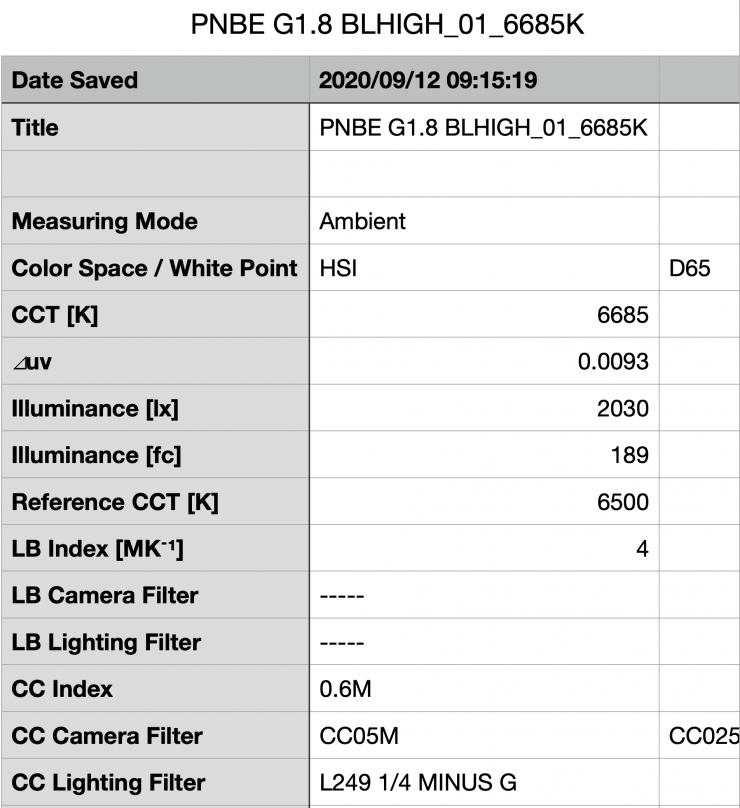
I tested the monitor by shooting a white card and exposing it at 100 IRE on a waveform. I then played back that clip and measured the brightness using a Sekonic C-800. The pnbe monitor had the backlight set to high, the brightness at 100, and the gamma set to 1.6. As you can see the monitor recorded a brightness level of 2030 lux, which slightly exceeded the claimed figure of 2000.
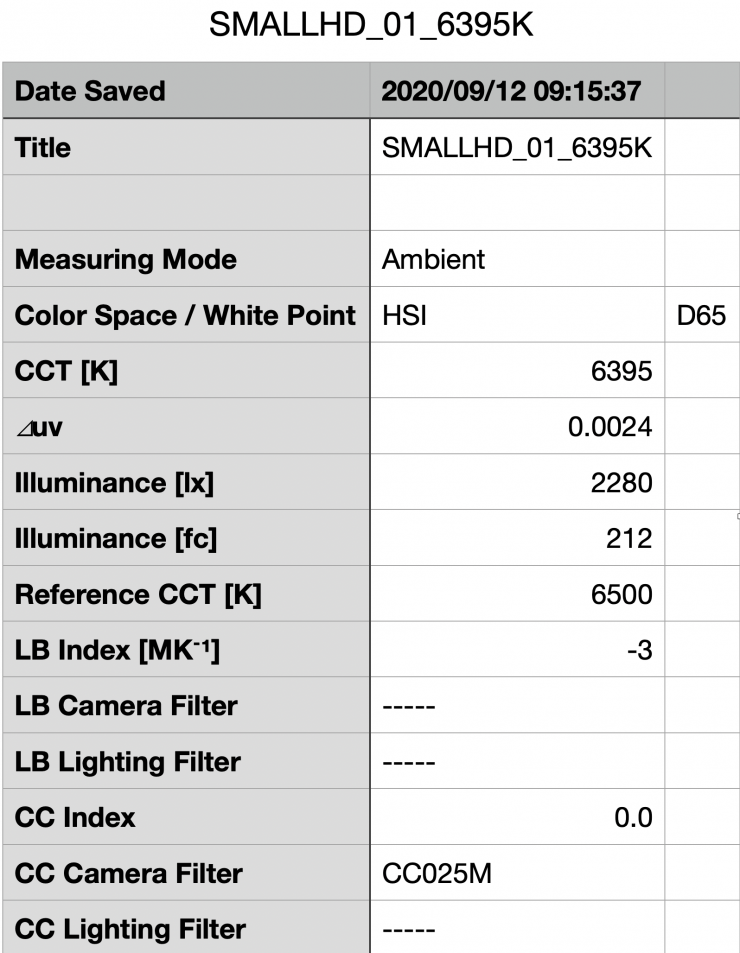
So how does that compare to a SmallHD Cine 7? Above you can see that the Cine 7 had a brightness of 2280 lux.
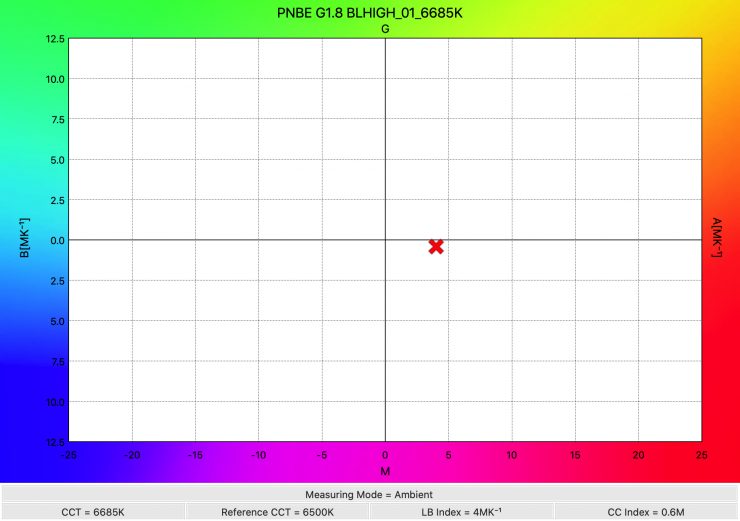
As far as color accuracy is concerned (the monitor’s Kelvin color temperature was set at 6500K) it recorded 6685K.
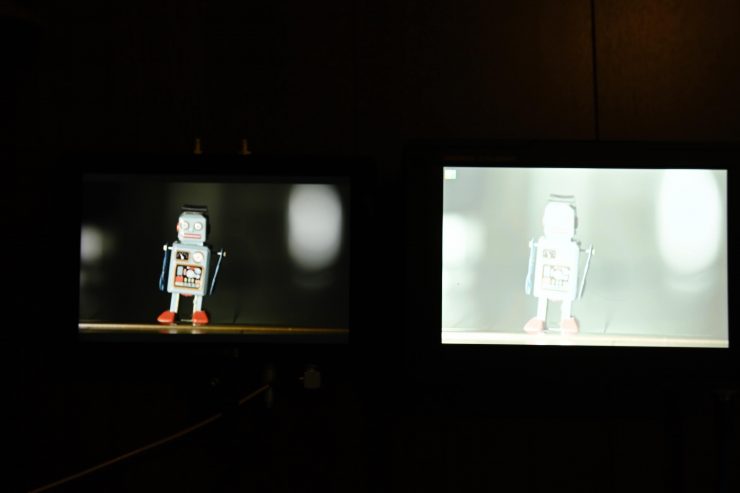
Here is the problem though, when you have the brightness turned to 100, the backlight at high, and the Gamma at 1.6 to achieve 2000 nits the image is completely washed out. Above you can see the SmallHD Cine 7 and the pnbe side by side at their maximum brightness levels. This is where a lot of the affordable ultra-bright monitors fall over. You increase the brightness and the image becomes unviewable.
Now, this doesn’t mean it isn’t usable outdoors in bright conditions. I still found the monitor was bright enough to be used even with the brightness level turned down. While it isn’t as bright as a SmallHD when viewing outdoors, it still manages to hold its own.
Operating System
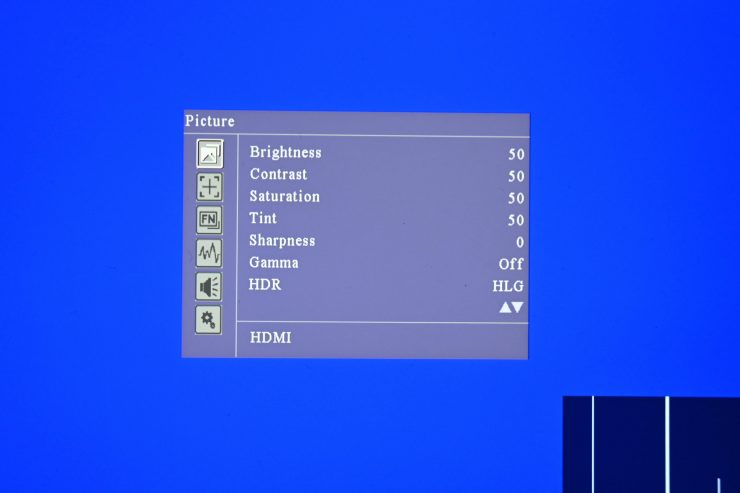
The operating system of the monitor is very old school. This is not a touch screen interface and you need to use a series of buttons to make any changes. Having used SmallHD’s fantastic Page OS system over the last few years I find it very hard to go back to non-touchscreen monitors.
While everything on the monitor works as advertised, the operating system is just not intuitive and easy to use. In an age where most people are used to touchscreen devices, this just feels antiquated.
It is not quick or easy to make adjustments or changes, and because there is only one function button, you continually need to keep going into the menu.
Usability
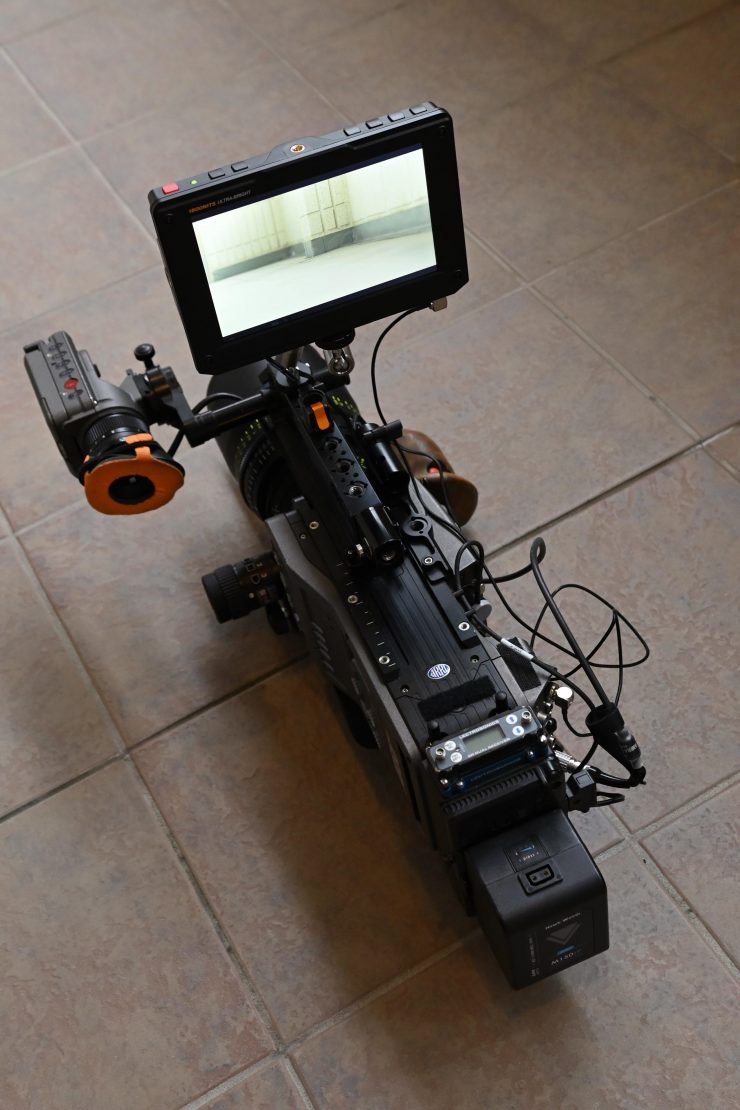
As I just mentioned the lack of touch screen operation and the slightly clunky menu system doesn’t make for the best user experience. With monitors, you need to be able to access assist tools quickly. Unfortunately, with this monitor that is not easy to do. I constantly found myself getting frustrated when using it because I couldn’t access the monitoring tools I wanted without going through menus.
The other problem is, once you make a change and you get out of the menu and you then want to go back into the menu it doesn’t go back to the same page you were on, it just reverts back to the main menu page. So, if for instance, I wanted to change from 2x image zoom to 4x image zoom it becomes a tedious process and it requires 5 presses of various buttons to make the change.
How does it compare to a SmallHD Cine7?
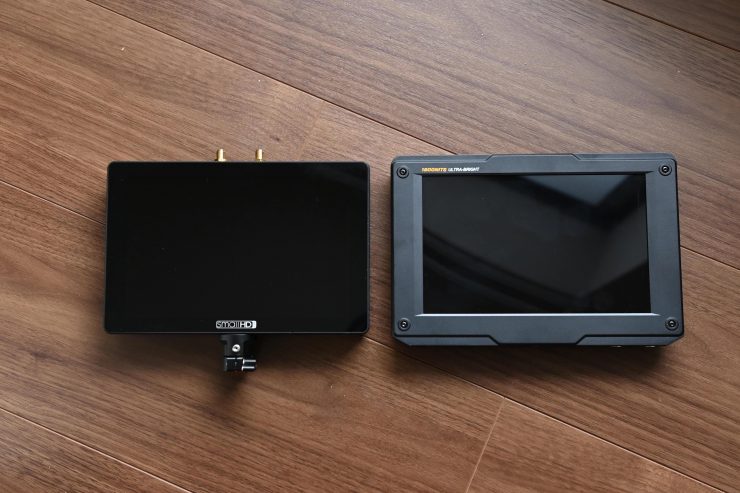
As the pnbe monitor apparently uses the exact same screen as the SmallHD Cine 7, so I thought I would compare the two. Now, there is a monumental difference in price between these two monitors and I don’t for one second think that the pnbe will be anywhere as good as the SmallHD Cine 7.
To maintain a fair playing field I output the exact same image from the ARRI Amira to both monitors. That way I could see exactly how each image appeared.
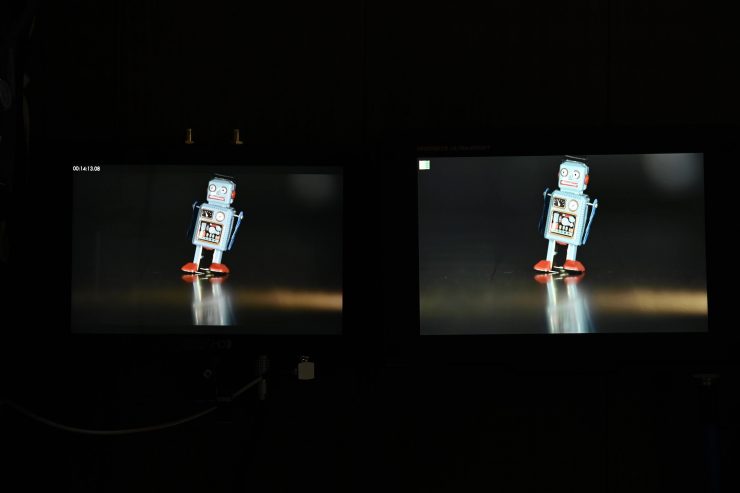
In their default configurations, this is how they looked. The pnbe was brighter and the blacks were more elevated, but the colors were a little skewed towards green. You can clearly see that in the above photo.
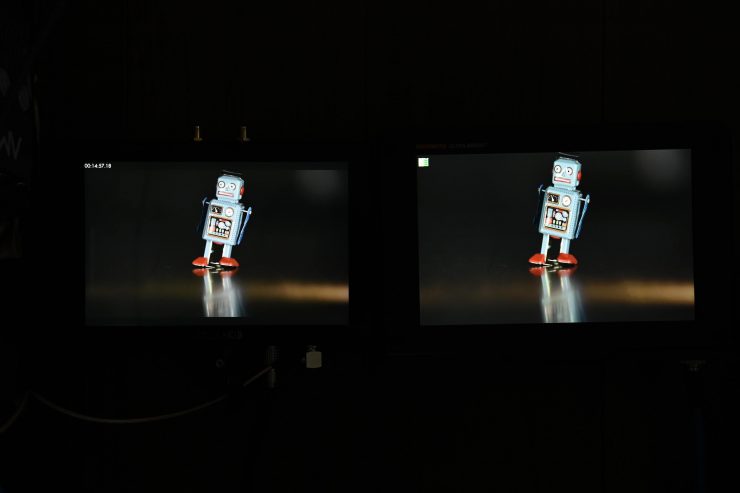
I went into the menu and adjusted the Gamma setting on the pnbe to 2.6 and above you can see that the images are now more similar.
I personally preferred the image I was seeing with the SmallHD, but in saying that, the image I was getting on the pnbe was pretty good considering the massive difference in price.
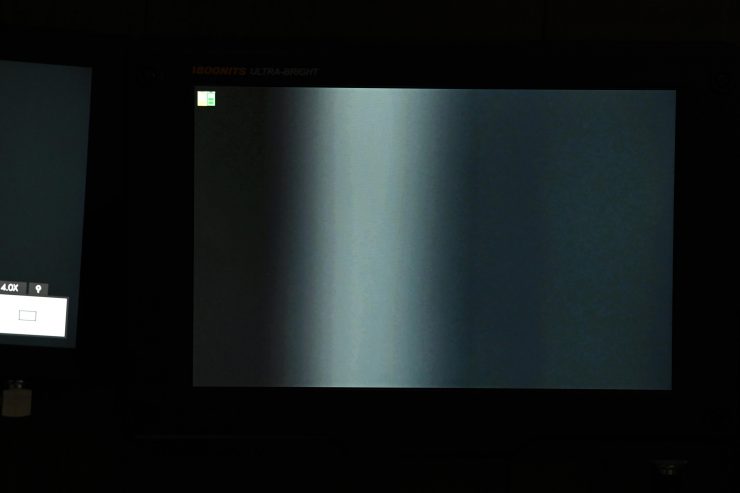

pnbe 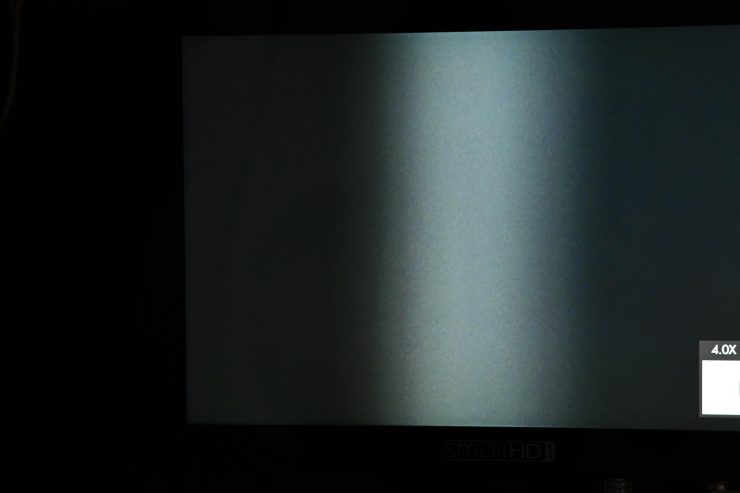
SmallHD
The bad news is that I was seeing a lot of banding and image artifacts being displayed on the pnbe monitor. I am not sure why this was happening, but it was very noticeable. Above I have put up a few photos when image zoom is being applied so you can see what I am referring to.
UPDATE: Now, I spoke to pnbe about this directly and they are already rectifying the problem They will be releasing a firmware update next week that will address the banding and artifact issues.
Apart from the image, the SmallHD’s operating system and touch screen functionality make it a far easier monitor to use. Image quality is one thing, but a good monitor should be easy to operate and use.
Price & Availability
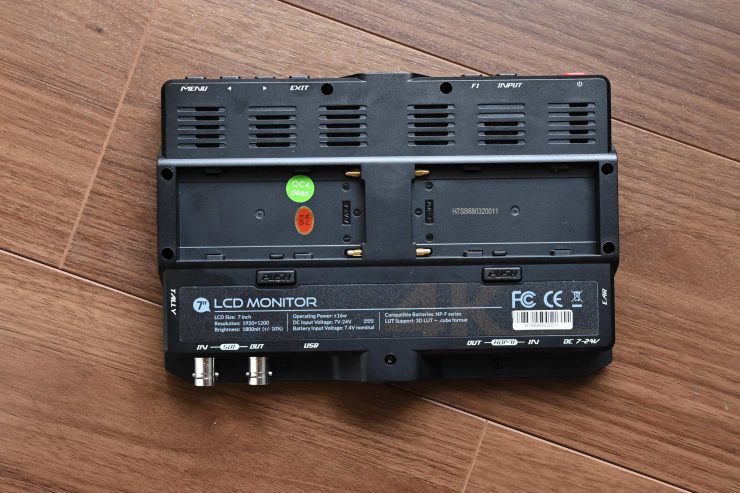
The 7″ monitors will start shipping from the 15th of October. You can now order them for the following prices:
- 7″ 2000 NIT HDMI $199 USD
- 7″ 2000 NIT HDMI+SDI $229 USD
pnbe will also have smaller 5″ and 6″ monitors as well as HDMI only versions available.
At $229 USD this monitor is 550% cheaper than a SmallHD Cine 7.
Competition
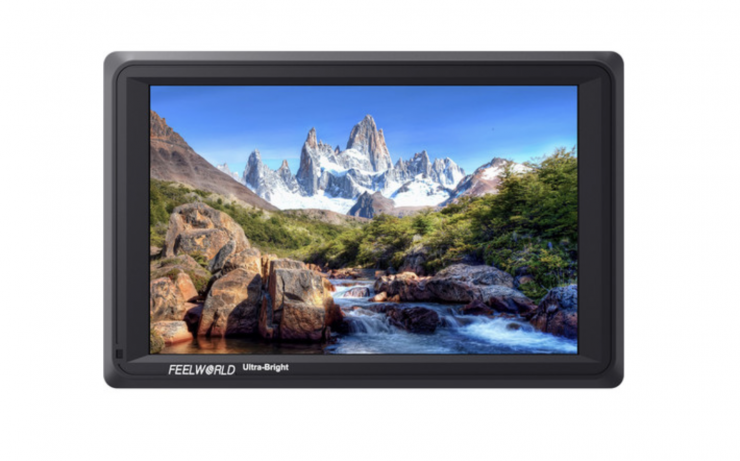
While I have been comparing it to the SmallHD Cine 7, its direct competition is more realistically from the following monitors:
- FeelWorld 7″ 4K Ultra-Bright Monitor with Loop-Through HDMI and 3G-SDI $339 USD
- Lilliput FS7 7″ 4K HDMI/3G-SDI Monitor with L-Series Type Plate $239 USD
- FeelWorld 7″ 2200 cd/m² Full HD 3G-SDI/HDMI On-Camera Monitor with 4K Support $299 USD
Now, how do these monitors actually compare to the pnbe on paper?
| NITS | HDMI | SDI | POWER DRAW | WEIGHT | |
| pnbe | 2000 | In/Out | In/Out | 16W | 360g |
| FeelWorld 7″ 4K Ultra-Bright | 2200 | In/Out | In/Out | 18W | 395g |
| Lilliput FS7 7″ | 500 | In/Out | In/Out | >12W | 435g |
| FeelWorld 7″ 2200 cd/m² | 2200 | In/Out | In/Out | NA | 500g |
The pnbe offers a lot of the same functionality as these other monitors but at a lower price.
Conclusion
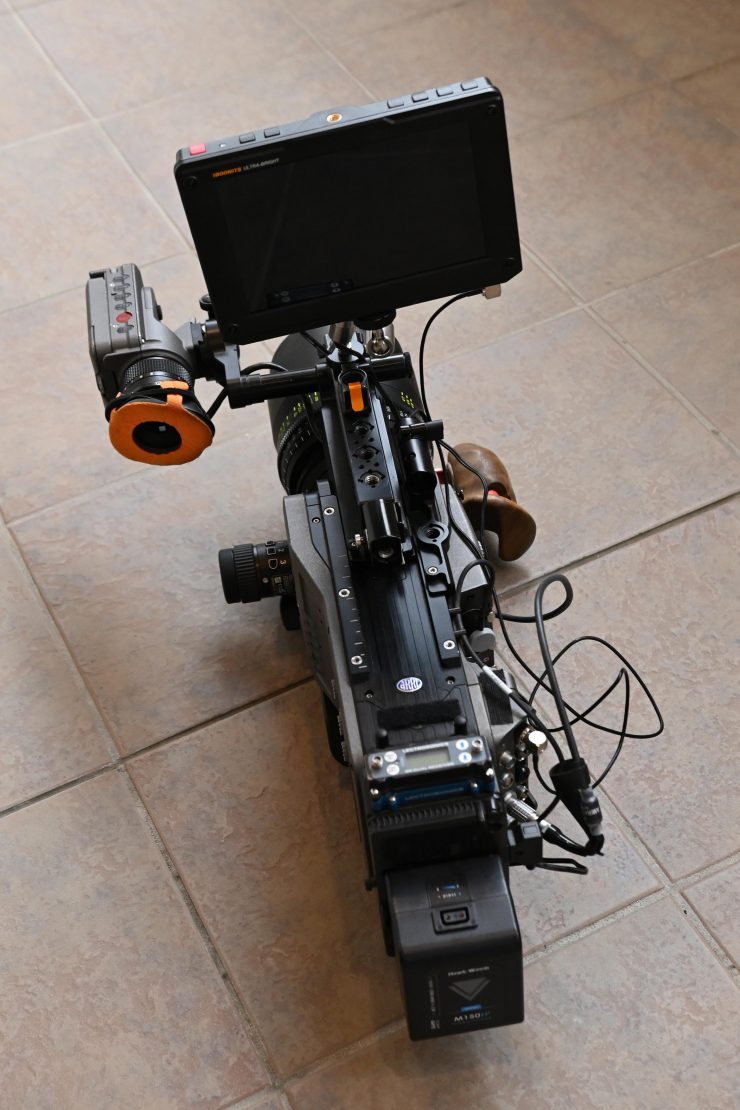
The pnbe monitor is a bit of a mixed bag. At its price it isn’t designed to compete with monitors like the SmallHD Cine 7, instead, it is supposed to be a budget-friendly alternative.
At under $230 USD it represents tremendous value for money if you compare it to other available options on the market. A SmallHD 7″ Cine 7 Touchscreen On-Camera Monitor is $1,499 USD (on sale).
While I don’t mind the design and the screen is pretty good, the biggest let down for me is the operating system. It just isn’t quick nor easy to make adjustments when you need to. I dislike having to go into menus continually to make changes. I think most potential users of this monitor would be happy to pay more money just to get touch screen functionality.
I applaud pnbe for making a monitor, and for a first out effort it isn’t bad, however, it feels a little bit like a Linux product in a Mac world. Don’t get me wrong, there is a lot to like, but usability is just as important as image quality.
I saying that it is very hard to fault a monitor at this price and I don’t want to sound overly critical, because this monitor represents very good value for money.
It is also important to support fellow people in the industry who are bringing products to market with the intention of getting them into the hands of users at affordable prices.
Like what we do and want to support Newsshooter? Consider becoming a Patreon supporter and help us to continue being the best source of news and reviews for professional tools for the independent filmmaker.

